
Not surprisingly, the gorge attracts approximately 2 million people each year with varying levels of outdoor prowess. Over 281 miles of trails traverse the Columbia River Gorge National Scenic Area. More than 40 waterfalls splash down the Oregon side with 13 more opposite the mighty Columbia, in Washington state. Two wild and scenic rivers, the Lower White Salmon River and the Lower Klickitat River, twist and turn across the land.
The well informed venture forth with current knowledge of trail conditions, carefully prepared backpacks (see the 10 essentials below) and the knowledge of how to use a map and compass. Then there are those of us who could use a refresher on the basics.
A safe adventure
If you’re new to hiking, consider trying it out with a skilled group like Oregon’s Mazamas, founded in 1894 on the summit of Mount Hood. Each year, the Mazamas offers roughly 900 hikes and 350 climbs for more than 13,000 participants. It also provides a variety of classes and activities for every skill and fitness level while promoting safety and the protection of mountain environments. The Mazamas has been an important part of the climbing community in the Pacific Northwest since its founding and offers lifetime membership to anyone who summits a high glaciated peak like Mount St. Helens or South Sister — although that’s certainly not a prerequisite to join any hike, climb or class.
The 10 essentials for a safe hike
A good motto for any trek into nature is the often-heard phrase, “always be prepared.” According to Oregon’s Mazamas, the 10 essentials to toss in your daypack for a safe hike include the following:
- Whistle
- Fire starter and waterproof matches
- Map — know how to read it
- Pocketknife
- Compass — know how to use it
- First aid kit — visit the American Red Cross website or NOLS to learn the basics
- Sun protection (lip balm, sunscreen and a hat)
- Extra layers for warmth (hat, socks and gloves)
- Flashlight (with extra bulb and batteries)
- Extra food (energy bar or trail mix)
Proper footwear for a safe stride
Once you’ve slung your backpack over your shoulders, hiking the gorge also requires sturdy footwear for traction on rocks, mud and slippery terrain. The fit of your boot or hiking shoe is crucial to a sure-footed stride for every step of your hike. A visit to an outdoor store such as Next Adventure for a proper fitting can be a good place to start if you’re overwhelmed by the choices. Additionally, if you’re concerned about previous ankle or foot trauma — from bunions to arthritis — The Portland Clinic’s foot and ankle specialists can help you confidently take a step in the right direction as you prepare for explorations in the gorge.
With a little planning, you can have a safe and pleasantly memorable trip. If you have questions about potential risks of new workouts or would like a physical exam to make sure you’re in tip-top condition before venturing out, please make an appointment with your doctor.


